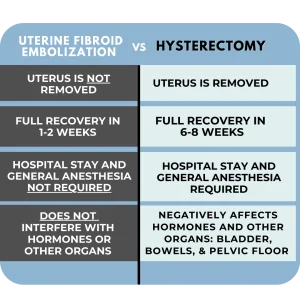Can Uterine Fibroids Cause Weight Gain?

As women approach the height of their childbearing years, they may start to notice some unusual changes, such as heavy menstrual flow, increased menstrual cramping, abdominal pain, and difficult urination. If any of these symptoms are applicable to you, you may be experiencing Uterine Fibroids. In addition to all these other uncomfortable symptoms, you could also notice weight gain in your abdominal region. Can Uterine Fibroids cause weight gain?
The answer is yes. Uterine Fibroids can cause weight gain. When fibroids get very large, they can cause the abdomen to enlarge, making a woman look pregnant.
Uterine Fibroids and Weight Gain
There are typically two reasons as to why Uterine Fibroids cause weight gain. First, the presence of fibroids in the uterus can also lead to a hormonal imbalance. Hormones impact your metabolism and how your body signals hunger. Therefore, a hormonal imbalance, as can be seen with Uterine Fibroids, may lead to weight gain in the form of excess fat storage. Secondly, Uterine Fibroids can also cause weight gain because for their size. Uterine Fibroids can vary in size. Some can be as small as an apple seed, and other may be as large as a grapefruit. Fibroids can also grow, and as they grow, the abdomen can swell, making a woman look pregnant. The growing fibroid will typically mask itself as an increasing amount of belly fat.
What are Uterine Fibroids?
Uterine Fibroids are noncancerous growths in the uterus that often appear in women during childbearing years. About 20 to 80 percent of women develop fibroids by the time they reach the age of 50. Fibroids are most common in women during childbearing years.
Most fibroids grow in the wall of the uterus. Doctors put them into three groups based on where they grow: Submucosal fibroids grow in the uterine cavity. Intramural fibroids grow within the wall of the uterus. Subserosal fibroids grow on the outside of the uterus. Some fibroids can even grow on stalks that stem from the surface of the uterus or into the uterine cavity. These are called Pedunculated Fibroids and often have a mushroom-like appearance.
Who is at risk for Uterine Fibroids?
There are currently 35 million women suffering from Uterine Fibroids nationwide, making this condition extremely common. Certain risk factors that can increase a woman’s chance of developing Uterine Fibroids. Being aware of them now can help you to detect them before severe symptoms ensue.
- Age-As women age, fibroids become increasingly common, especially during your 30’s & 40’s. Once you begin going through menopause, however, fibroids usually shrink.
- Family History- If you have a history of Uterine Fibroids in your family, your chances of developing them greatly increase. In fact, studies show that if your mother has had Uterine Fibroids, your chances of developing them are three times higher than average.
- Ethnicity- Although it is unclear why, research has shown that Black women have a significantly higher chance of developing Uterine Fibroids.
- Diet- Certain food groups, such as excessive red meats and ham, have been linked to higher chances of developing Uterine Fibroids. Incorporating a healthy amount of green vegetables, however, can help to combat developing Uterine Fibroids.
Treating Uterine Fibroids at Pedes Orange County
Living with the uncomfortable symptoms associated with Uterine Fibroids- such as weight gain, abnormal menstrual cycles, or abdominal pain- can significantly decrease your quality of life. At Pedes Orange County, we want to help you feel like yourself again with a minimally invasive method of treatment.
Uterine Fibroid Embolization
Uterine Fibroid Embolization is a minimally invasive procedure that shrinks the fibroids without damaging the uterus. This procedure is also known as Uterine Artery Embolization (UAE). UFE can eliminate fibroids by accessing your arteries and slowing down the blood flow to the fibroids. This will cause the fibroids to shrink and disappear. 83% of women experience symptomatic relief after UFE.
The UFE procedure eliminates the need for major surgery, long recovery times, and the complications of having a hysterectomy. This procedure can be done in an outpatient setting and only requires light sedation and local anesthesia.
UFE is an outpatient procedure that usually takes between 1 and 2 hours. Patients usually require about 1 to 2 hours of recovery prior to going home the same day. Patients may experience mild discomfort as the embolization takes full effect. Over time the fibroids shrink due to a decreased blood supply. Mild discomfort and light bleeding may occur for a few weeks after the procedure. The typical recovery time is 48 to 72 hours with most patients returning to normal activity 7 to 10 days after the procedure.
Our Vascular Specialists perform UFE procedures on a regular basis at Pedes Orange County. Call our office to schedule a consultation today if you think you may be suffering from weight gain or abnormal menstrual cycles resulting from Uterine Fibroids, call our office to schedule a consultation today!












